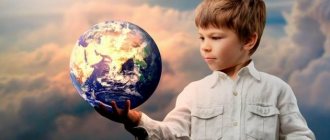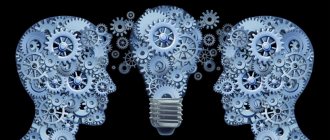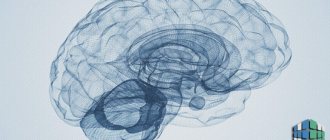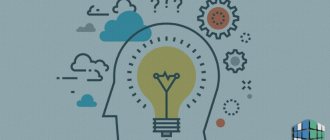The main basis of personality psychogenesis lies in the knowledge and transformation of the environment. Thanks to one’s own experience, mistakes and successes, sorrows and joys, a model of the world is formed in a person, which subsequently becomes a key part of his psyche. The cognitive sphere of the individual is responsible for these processes. What it is needs to be studied in more detail.
Cognitive sphere of personality
What is the cognitive sphere of personality?
In the 60s, when most scientists were fascinated by cybernetics, it became a habit in the scientific community to compare a person with a biocomputer. Higher minds often tried to model human mental processes. Thanks to these experiments, the word “cognitive” came into use, which means from Latin. cognitio – study, cognition, knowledge. If the results could be presented in the form of a logical and meaningful sequence of actions for processing information, then they were called cognitive processes, and in case of failure - affective processes.
Today, in psychology and pedagogy, cognitive or cognitive processes are the most important components of human consciousness. They are the ones who help people understand the world around them and adapt to it depending on the situation.
Important! If the cognitive sphere works correctly, any person has the ability to perceive, process and remember information. The main thing is that everything should happen logically and rationally.
In other words, the cognitive sphere of personality is a kind of mechanism that allows a person to learn throughout his life and at the same time apply the acquired knowledge. The cognitive field is studied by cognitive psychology.
What does cognitive psychology study?
Unusual experiment
With the gradual decline of the dominance of behaviorist concepts in 1971, psychologist Philip Zimbardo of Stanford University decided to take a bold step. Purpose of the study: to study the behavioral characteristics of a person in cruel conditions (limited freedom of action and will, pressure on moral principles). The recruitment of volunteers took about a month; not everyone was ready to calmly go to torture and obey any instructions. A total of twenty-four people were selected. In order to maintain the purity of the experiment, the candidates were divided into two groups. The first half included guards, and the other half included so-called prisoners. A laboratory assistant and an assistant psychologist acted as the main guards; Zimbardo himself became the manager of this research prison.
The subjects were "arrested" in their homes under false pretenses and under the direction of the Palo Alto police. The prisoners were transported to a fenced area, processed, assigned a number and placed in compartments. From the first minutes, the scientist began to record the mental reactions of the experiment participants and observe their behavior.
The experiment was originally designed to last two weeks, but ended after just six days due to the fact that things quickly got out of control. The “prisoners” were mocked, humiliated and even used physical violence. The “guards” quickly got used to the role and began to show sadistic tendencies, depriving the prisoners of sleep, forcing them to hold their hands up for a long time, etc. Many “prisoners” already experienced severe emotional distress and a feeling of depression on the third day of the experiment.
A significant result of the experiment can be considered the book by F. Zimbardo entitled “The Lucifer Effect” (2007), in which he described the effect of cognitive dissonance (conflict of emotional reactions in a person’s mind) and human obedience to obvious personal authority
Particular attention was paid to the influence of public opinion and the degree of government support, which can justify or reject the views of an individual
This was the most striking experiment in the field of cognitive psychology. For ethical reasons, no one else made similar attempts to repeat the experiment.
Structure
The cognitive domain is a cognitive tool. Therefore it includes the following processes:
- Perceptual, which includes attention, perception, sensations. Their main function is to obtain as much information as possible from the internal and external environment.
- Mnemonic, which includes memory and all its components: forgetting, reproduction, preservation, memorization. Their work is aimed at retaining the information received in the psyche for a long time.
- Intellectual, which includes speech, imagination, thinking. These processes are responsible for exchanging information, filling in missing data, and generating new images and conclusions.
Cognitive psychology - what it studies
The activity of the cognitive sphere depends on the development of the organism. For example, in earthworms only sensations are recorded, in frogs, which love to feast on long worms, perception is well developed, in herons, which will gladly eat a frog, one can observe not only perception, but also thinking with memory.
Additional Information. The most intelligent among birds are crows, and among the animal world - primates.
Similarly, there is a link between cognition and development in humans. A successful person in a social environment will be a more developed individual.
Attention
A person does not process all the information that he encounters along the path of life. Preference is given only to those incentives that are related to the interests and needs of a particular individual.
Types of attention
Important! Therefore, we can say that attention is the ability of the psyche to focus on certain objects. In this case, the individual can easily be distracted from everything else.
There are two classifications of attention:
- external, which is aimed at others;
- internal, which is focused on one’s own feelings and thoughts.
This division is considered conditional, since in most cases people prefer to immerse themselves in thinking about their behavior and actions.
If we take volitional regulation as the basis for the division of attention, then in this case it can be divided into 3 groups:
- arbitrary;
- involuntary;
- post-voluntary.
The emergence of involuntary attention occurs without any effort on the part of the individual. He has no goals or special intentions. This type of attention may arise for the following reasons:
- Because of internal motives. These may include a person’s needs, interests or mood.
- As a consequence of a certain stimulus. Contrast can play a decisive role (for example, an African American will attract more attention among Europeans), as well as unusualness (hairstyle or outfit), novelty (a new invention), surprise (if someone starts talking loudly in a crowd).
The emergence of voluntary attention occurs at the moment when an individual sets a goal to learn something. Among the main triggers are:
- Awareness of one's own responsibilities and tasks;
- Habitual conditions in which the same work is performed every day;
- If indirect interests are involved. For example, if a person wants to learn to play the guitar, he will first have to learn the theoretical part.
Post-voluntary attention occupies an intermediate position between voluntary and involuntary. It is characterized by the features of these two species. All types of attention can move from one to another over a short period of time.
Memory
All the information that a person receives from the outside world enters the brain in a continuous wave. There it is processed and recorded for later storage and playback. This is memory.
Memory types
There are 3 types of memory in humans:
- Long-term. The most important and complex type of memory. Its volumes are limitless. Long-term memory is responsible for everything that a person holds in his head for more than 2 minutes. The main difficulty of this type is finding the necessary information.
- Short-term. This type of memory is unable to recreate a complete picture of events that have occurred. She can only reproduce a small part. The information storage time is no more than 30 s.
- Instant. Such memory is a specific system that is capable of retaining information for 0.1-0.5 s.
In addition to the main types of memory, there are a large number of its types. By the nature of mental activity we can distinguish:
- Motor memory. Thanks to it, a person is able to remember and reproduce various movements.
- Emotional memory. It is associated with the individual's feelings, which are stored in the form of certain signals. They can both encourage action and, conversely, hold back.
- Figurative memory. Associated with remembering pictures, life events, sounds, tastes, smells.
- Verbal-logical memory. She works with a person's thoughts. Remembers and reproduces thoughts, experiences, the content of books read, conversations with friends.
All these types of memory are closely related to each other and are not activated individually.
Imagination
Imagination is a mental process through which a person is able to create an image of a situation or object by rearranging existing data about them.
Important! Images in the imagination do not always correspond to reality. They contain elements of fiction and fantasy.
The process of imagination is inextricably linked with thinking and memory. It can manifest itself in different ways. To realize this, it is necessary to study the main types of imagination.
Types of imagination
Based on the degree of activity, there are:
- Passive imagination. The created images are not reflected in real life. They replace reality with dreams and fantasies.
- Active imagination. It is related to the completion of a specific task. First, a person imagines an image of the result he wants to achieve, then develops a plan to implement his plan.
Active imagination is also divided into:
- Recreating. This type of imagination is characterized by the presentation of new material, which is supported by a verbal description or conventional image. For example, these are drawings, maps, notes. This type of imagination is activated during learning.
- Creative. It is characterized by the independent creation of previously unknown images. This type of imagination is used when writing novels and musical works.
Criticism
In the early years of cognitive psychology, behaviorist critics believed that the empiricism it pursued was incompatible with the concept of internal mental states. Cognitive neuroscience, however, continues to accumulate evidence of direct correlations between physiological brain activity and putative mental states, supporting the foundations of cognitive psychology.
Some observers suggest that as cognitive psychology became a movement during the 1970s, the complexity of the phenomena and processes it studied meant that it also began to lose cohesion as a field of study.
If you find an error, please select a piece of text and press Ctrl+Enter.
The relationship between emotional and cognitive spheres
Personality orientation - what is it in psychology, its types
If a person is mentally developed, both his cognitive and emotional spheres are fully activated. Thanks to them, he is a complete person.
Additional Information. Some people often succumb to emotional impulses, but despite this, in difficult and responsible situations they use the cognitive side of the personality.
The relationship between the rational and emotional spheres lies in the fact that, no matter what a person does, no matter what work he does, he does not cease to feel. If his emotional impulses begin to intensify, he makes every effort to logically comprehend his subsequent actions and the consequences of them.
Diagnostics of the cognitive sphere
Human personality degradation - what is it?
There are, including on the Internet, a large number of tests that allow you to determine at what level of development a person’s cognitive sphere is. The main diagnostic methods can be found in the table.
Methods for diagnosing the cognitive sphere
| Cognitive process | Cognitive process |
| Attention | Landolt Ring Technique |
| “Proofreading test” technique | |
| "Munstenberg" technique | |
| Memory | Test for analysis of associative memory. To do this, you need to read 10 pairs of homogeneous words that are interconnected in meaning. After this, the examiner must read the first word, and the test subject must pronounce the second. |
| Wechsler subtest | |
| A test to memorize 10 words, between which there is no meaning and no common connection. | |
| Imagination | Thinker-Artist Test |
| Torrance testing | |
| Toulouse-Pieron test |
Thanks to these tests, it is possible to identify problems that are present in the cognitive sphere of a person.
Imagination is a truly human ability
One of the most important differences in the activities of humans and animals is that people project (imagine) the end result of their actions before doing anything. This happens thanks to such an ability as imagination. It provides people with the ability to create an image of an object that does not exist in the real world, hold it, and even moreover, manipulate it.
The development of the cognitive sphere in general and imagination in particular is important for generating solutions in the absence of complete information. With the ability to design theoretical models, people can not only imagine the final result of actions, but also “see” the intermediate products.
Cognitive sphere of personality in a child
Jean Piaget was the first to pay attention to cognitive development. In his writings, he expressed a lot of thoughts about the need for people to develop memory, imagination and other cognitive processes.
Additional Information. He believed that the thought processes of preschoolers are no different from adults. Therefore, all conscious actions that they perform lead to the development of cognitive abilities. The more time a child spends understanding the world around him, the easier it becomes for him to assimilate complex information.
In addition to Piaget, the cognitive sphere was studied by such famous psychologists as A.A. Leontyev, L.S. Vygotsky, S.L. Rubenstein. They believed:
- the basis for the development of the cognitive sphere is language and speech;
- Thanks to the perception of conversations between adults and peers, children develop their own speech skills.
The cognitive sphere of children of primary preschool, school and adolescence can be checked in the same way as in adults - with the help of tests. Timely identification of problems helps to correct poor performance in school.
Modern Perspectives
Contemporary views of cognitive psychology typically view cognition as a dual process theory outlined by Daniel Kahneman in 2011. Kahneman distinguished more between the two processing styles, calling them intuition and reasoning. Intuition (or system 1), similar to associative thinking, has been defined as fast and automatic, usually with strong emotional connections included in the thinking process. Kahneman said that this kind of reasoning is based on established habits and is very difficult to change or manipulate. Reasoning (or System 2) was slower and much more variable, being subject to conscious judgments and views.
Examples of cognitive processes
Each person has a specific set of cognitive abilities that allows them to perform daily tasks. Thanks to perception and sensations, an individual can easily experience the world without visible effort.
For example:
- Thanks to vision, people are able to observe a large number of visual objects, which include people, houses, and road signs.
- When a student looks at a book, he or she can remember a literature lesson.
- With the help of hearing, a person is able to hear a huge range of sounds and tones.
- With the help of memory, people are able to find answers to many questions, as well as reproduce any important information at the required moment in time.
For example:
- thanks to memory, people know their date of birth, address and telephone number;
- a person is able to reproduce information from the past;
- various smells, sights and sounds can remind people of some significant event;
- Listening to a song, a person can remember his childhood or his beloved.
Thanks to attention, people capture the signals, information, knowledge and skills they need.
For example:
- when a person wants to say something, his interlocutor tries to focus attention on him so as not to miss important words;
- If at school a teacher asks a student to make a report, then, thanks to his attention, the student will be able to complete it.
Without the cognitive sphere, a person would not be able to enjoy all the delights of the world around him. Communication with other people would be impossible. Therefore, people should take care of their cognitive processes, constantly develop them and maintain them in good condition. If age-related problems are identified, consult a doctor immediately.










